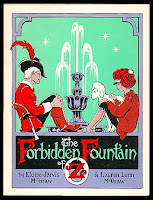 The Ozmapolitan
The Ozmapolitan was a clever publicity gimmick created in 1904 by Reilly & Britton to advertise the new Oz book,
The Marvelous Land of Oz. This newspaper of the Emerald City was a giveaway item, with various articles relating to the new Oz title. Another issue was produced in 1905 to advertise
The Wogglebug Book.
The idea doesn't seem to have been used again until the 1920s.
The Ozmapolitan was revived to help advertise several of the Ruth Plumly Thompson
Oz books of that time period. However, after a few years the paper disappeared once more.

It had another revival in the 1960's, when Reilly & Lee published their final Oz title,
Merry Go Round in Oz, and produced the new "white cover" editions of the Oz books. These books are so called because the cover designs were printed in color on sturdy white fabric bindings. Dick Martin redesigned original John R. Neill covers for these books, dropping the contemporary cover designs which were then in use. The back page of the
Ozmapolitan shown on the left advertises the new editions, including the short lived version of
The Wizard of Oz that used a W. W. Denslow poster design for the cover. The covers shown for
Land of Oz and
Ozma of Oz are also interesting, as they are not the actual "white cover" editions that were produced, but appear to be mock-ups of the books. It's worth noting that the new editions were 45 cents more expensive than the titles which were not redesigned!
I don't have any of the older issues of the paper, but I do have the 1965 and 1970 versions. I also have the 1986 version printed by the International Wizard of Oz Club to advertise the new Oz book by Dick Martin,
The Ozmapolitan of Oz. I've always thought this idea was a lot of fun, and it's unfortunate that more issues were not created!
Hungry Tiger Press has the various papers available as free downloads on their website -
http://www.hungrytigerpress.com/tigertreats/ozmapolitan.shtml



















































